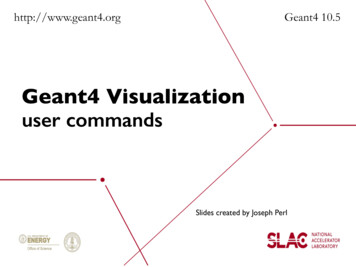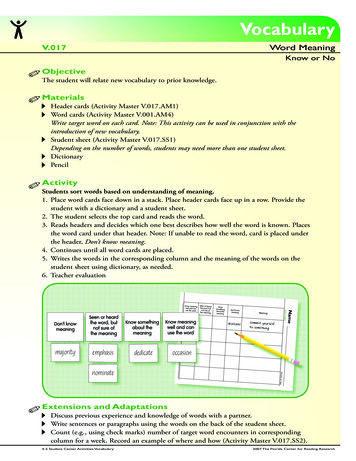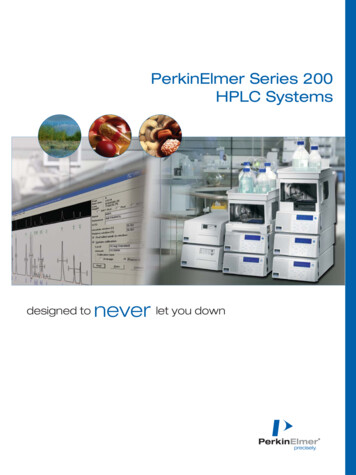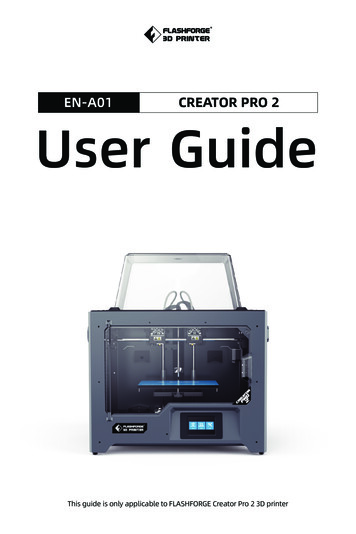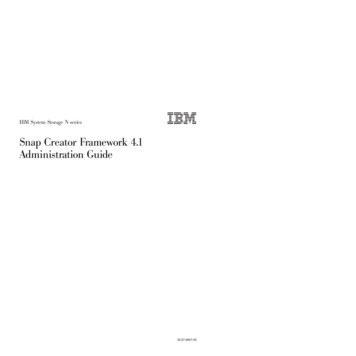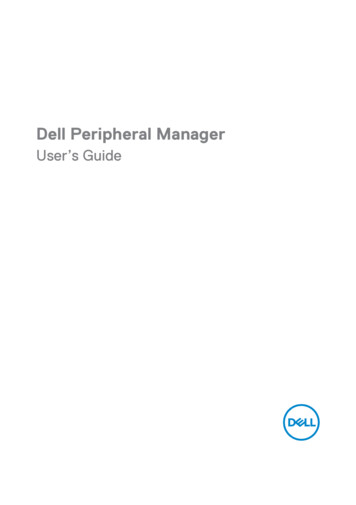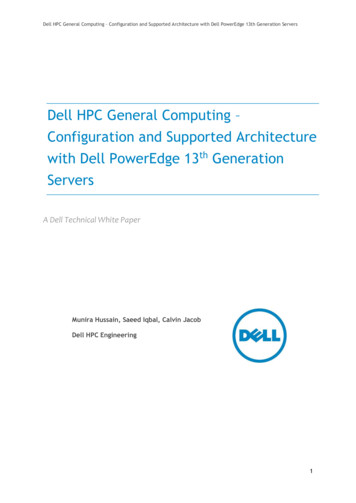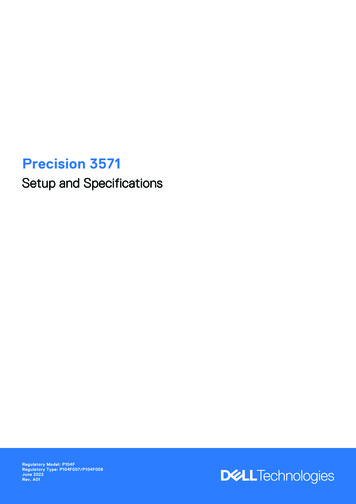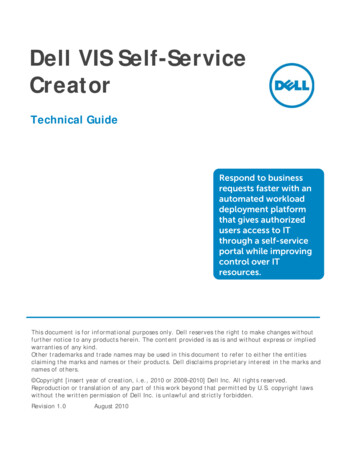
Transcription
Dell VIS Self-ServiceCreatorTechnical GuideRespond to businessrequests faster with anautomated workloaddeployment platformthat gives authorizedusers access to ITthrough a self-serviceportal while improvingcontrol over ITresources.This document is for informational purposes only. Dell reserves the right to make changes withoutfurther notice to any products herein. The content provided is as is and without express or impliedwarranties of any kind.Other trademarks and trade names may be used in this document to refer to either the entitiesclaiming the marks and names or their products. Dell disclaims proprietary interest in the marks andnames of others. Copyright [insert year of creation, i.e., 2010 or 2008–2010] Dell Inc. All rights reserved.Reproduction or translation of any part of this work beyond that permitted by U.S. copyright lawswithout the written permission of Dell Inc. is unlawful and strictly forbidden.Revision 1.0August 2010
Dell VIS Self-Service CreatorTable of Contents1Overview . 21.1Dell Virtual Integrated System (VIS) . 21.2Dell VIS Self-Service Creator . 21.3Dell VIS Self-Service Creator Feature Overview . 32Product Features . 42.1Role-based Self-Service Portal . 52.1.1Requesting new virtual workloads . 62.1.23456Managing existing virtual workloads . 62.2Governance with policy-based automation . 72.3Extensive support for existing tools & Heterogeneous software. 82.4Delivery of Virtual Desktops . 92.5VM Sprawl Control . 10Deploying Dell VIS Self-Service Creator . 113.1Getting Dell VIS Self-Service Creator . 113.2License activation process . 123.3Supported Languages . 133.4Supported Hardware & Software . 133.5Software download, installation and configuration . 14Support . 144.1Level 1 . 144.2Level 2 . 144.3Level 3 . 14Licensing Options . 155.1Perpetual License . 15Resources . 156.1Technical Documentation . 15VIS Self-Service Creator Technical Guidebook1
Dell VIS Self-Service Creator1 OverviewThe Virtual Integrated System (VIS) brings together an end-to-end solution constituting ofstate-of-the-art servers, storage, networking, and software tools to work as one dynamicallyconfigurable entity that is open and pragmatic. The result is a fast-to-deploy and responsiveinfrastructure that helps businesses respond to customers’ and employees’ changing needs.Dell’s solution is a distinct alternative to the closed nature of competitors’ proprietary andvertically integrated stack.With the economic challenges facing most companies today, customers have adoptedvirtualization as an approach to lowering their operational costs as well as improving theiroverall business agility. While virtualization has delivered to its promises, the managementof virtualized infrastructures has become more challenging. Management is getting complex since the environment is scaling and changing rapidlyLong lead times between requesting for provisioning virtual machinesCurrent virtualization deployment tools do not enforce governance & complianceDue to the ease of deploying a VM, VM Sprawl is a significant challengeDo not have a solution to support a multi-vendor environment1.1 Dell Virtual Integrated System (VIS)Dell’s Virtual Integrated System Architecture is composed of three key components; DellAdvanced Infrastruture Manager (AIM), VIS Self-Service Creator and VIS Director.The Dell Advanced Infrastructure Manager (AIM) solution is a single managementpoint for physical and virtual resources that can accelerate provisioning of newhardware and applications while providing improved efficiency and maximizingflexibility. It simplifies the process of making changes in the data center bycombining servers, storage, network and workloads into a unified solution thatdynamically allocates resources.The Dell VIS Self-Service Creator Unlock the hidden efficiencies in your data centerby improving time to productivity and control of your IT environment by automatingthe deployment of virtual server and desktop workloads with the Dell VIS Self-ServiceCreator. This automated self-service tool empowers authorized users to deploy andmonitor resources while enabling IT to improve response time and control.The Dell VIS Director is the command center for Dell’s next generation data center.It offers IT professionals an intuitive end-to-end view of the data center by logicallylinking physical and virtual resources. The level of visibility, automation andcustomization of VIS Director helps organization ensure that performance andresource utilization are optimized, service levels are met and problems are solvedquickly.1.2 Dell VIS Self-Service CreatorThe Dell VIS Self-Service Creator is a key component of the VIS product portfolio. It is anautomated workload deployment and management platform for virtual servers and desktopsVIS Self-Service Creator Technical Guidebook2
Dell VIS Self-Service Creatorproviding authorized users a self-service portal to select and deploy resources automaticallyas well as manage the resources throughout their lifecycle. IT administrators can customizean extensive set of out-of-the-box workflows to automate many of the day-to-day tasksassociated with service delivery. This enables IT resources to focus on other strategicinitiatives. All this is done seamlessly with the ability to orchestrate these services acrossmultivendor components including hypervisors, connection brokers, image deploymenttechnologies and other management systems. The VIS Self-Service Creator is designed toincrease access, control and flexibility, which can add up to significant CapEx and OpExsavings and improved service delivery times.1.3 Dell VIS Self-Service Creator Feature OverviewFeatureFunctionBenefitSelf-Service Portal Automated, policy-enforceddelivery of IT server anddesktop workloads frominitial provisioning throughdecommissioning andarchival Designed to eliminate overprovisioning andunauthorized usage Identify and reclaim inactiveand abandoned resources Automate thedecommissioning and reuseof retired resources A template that outlines theresource allocation, designparameters, and processautomation considerationsthat control how theresource will be managedthroughout its life Improve service delivery fromdays to minutes Delegate responsibility whilemaintaining operational controlAutomated SprawlControlWorkloadTemplatesBusiness Grouping Multi-tier organizationalgrouping Organizes resources,policies, processes, andmanagement-accesscontrols for each group orservice tier.ResourceReservations Reserve resources andestablish service tiers in ashared infrastructure forspecific uses and/or groupsVIS Self-Service Creator Technical Guidebook Re-using reclaimed equipmentcan help lower capital costs Improve resource utilization Designed to deliver the rightsize machine at the rightservice-level, reducing overprovisioning Standardize IT processes tohelp enforce governance andcontrols throughout themachine’s life Flexibility to allocate the rightamount of resources to eachbusiness group Ability to set up different ITservices, processes, policies fordifferent groups Control resource consumption Helps assure that resources areavailable when needed andreallocate resources as3
Dell VIS Self-Service CreatorFeatureFunctionBenefitnecessary to meet shiftingbusiness prioritiesAccess ilityMultiple ImageDeploymentOptionsSupports Desktopsand ServerProvisioning Identifies and specifies therights of authorized users ofspecific resources andbusiness groups Flexible approval process thatgives the option of simple orcomplex approval policies fordifferent managementactivities Orchestrate delivery acrossmulti-vendor technologystackso Hypervisorso Image/App Deploymento Connection Brokerso Management tools Platform tools like WindowsWIM Imaging, MicrosoftSCCM, and Linux Kickstart Enterprise management toolslike BMC BladeLogic, HPServer Automation, andothers Space-efficient tools likeCitrix Provisioning Server andNetApp FlexClone Provisioning andmanagement acrossdesktops and servers Integration with the desktopecosystem Allows IT to strictly control whocan reserve and deploy valuableresources Standardize IT approvalprocesses without sacrificingoptions Works with what you alreadyhave deployed and providesfuture-ready platform as yourIT groups Avoid technology lock in Flexibility to fit into yourexisting environment Protect investment in existingtools and processes Single tool for desktops andservers Common portal for allconfiguration requests2 Product FeaturesAn enterprise typically has multiple types of IT consumers who want different things fromthe IT organization. IT’s challenge is mapping workload services to users with as muchflexibility as possible to accommodate each group’s requirements. Dell VIS Self-ServiceCreator provides the industry’s most flexible platform for rapidly automating the delivery andmanagement of virtual workloads.VIS Self-Service Creator maps virtual workloads to users automatically based on policies andprocesses established by IT. Moreover, these policies automate and manage the workloadlifecycle from requisition through retirement.VIS Self-Service Creator Technical Guidebook4
Dell VIS Self-Service CreatorIT administrators can use out of the box workflows and be up and running on day one. Thetime to value for a customized solution is also faster than other vendor offerings or in-housedevelopment.With the Dell VIS Self-Service Creator, IT can easily be responsive to the diverse needs ofbusiness lines, server and desktop users, development and production, and other groups —likely for the first time.2.1 Role-based Self-Service PortalThe Self-Service portal is one of the key features of the Dell VIS Self-Service Creator. Inaligning with the goal of VIS to improve operational efficiencies in the datacenter via ITProcess automation, the self-service portal frees up IT administrators from repeated manualactivities while empowering end-users to request for the “right” workload. With a view intothe cost and the capacity of the virtual workloads, end-users are given the choice of choosingthe workload that best meets their requirements. The always available on-demand capabilityof the portal also results in significant improvement in the end-user’s customer experience.VIS Self-Service Creator Technical Guidebook5
Dell VIS Self-Service CreatorThe end-user is the audience the IT department serves. The Dell VIS Self-Service Creatorexposes a minimalistic self-service end-user portal from where the end-user can request fornew virtual workloads and also manage existing workloads already owned by then end-user.2.1.1 Requesting new virtual workloadsOn the VIS Self-Service Creator end-user console, the end-user has a view of a catalog ofworkloads that the user has access to based on provisioning group memberships. Ifconfigured by the administrator, the end-user has visibility into the cost of the individualresources. The user selects a workload, indicates the number of machines desired, makesother choices that may be available, and submites the machine request.If the request workflow requires approval, the request is sent to the group manager, one ormore outside approvers, or both, all of whom must approve the request.When the request is approved, or if it does not require approval, the machine is provisionedfrom one of the provisioning group’s reservations, built using the workflow, specificationsand properties detailed in the blueprint, and turned on. Finally, the end-user is notified of theavailability of the virtual workload2.1.2 Managing existing virtual workloadsOn the VIS Self-Service Creator end-user console, the end-user can also view all theworkloads owned by the user, can connect to any machine, and perform operations on itsuch as turning it off and on, re-provisioning it to its initial state, expiring it and evendestroying it. The user can also check the lease status of the machine and ask the group’smanagers to extend the lease if necessary.When the machine’s lease expires, or it is manually expired, the machine can no longer beoperated or reprovisioned. If the workload definition specifies an archive period, however,the machine’s owner can request reactivation by a group manager at any time before thatarchive period ends. This allows the owner to retrieve data left on the machine or to extendVIS Self-Service Creator Technical Guidebook6
Dell VIS Self-Service Creatorits use as changing circumstances require. Enterprise administrators can also search for andidentify unused or underused machines and reclaim them (with the consent of the user)through early expiration.When the end of the archive period is reached, or if there is no archive period, the machineis destroyed. The resources that provisioned it are now available to provision new machines.2.2 Governance with policy-based automationThe ability to integrate both IT and business policies into the workload delivery workflows isa cornerstone capability of the Dell VIS Self-Service Creator. Policy based automation isenabled by creating groups that maps a specific set of users to pre-defined set of workloadsthat can be deployed to a pre-defined allocation of hardware resources. Before users canaccess resources, the administrator defines policies used to limit resource access, assure thatbuilds are configured to standards, and enforce process workflows including approvals. SelfService Creator can be customized for a company’s unique environment by creating thesepolicies Business Groups: Allows virtual workloads, resources, policies, processes, andmanagement-access controls to be grouped into various groupings to provide thecapability for IT to support various business functions Authorized Users: Identifies users authorized to access workloads and utilize physicalresources and also specifies the rights of each user Service Blueprints: Provides a catalog of available virtual workloads and contains plansand specifications for building, managing, reclaiming, decommissioning, and archivingeach virtual workload Resource Reservations: Reserves dedicated compute resources from shared physicalinfrastructure which can then be allocated to business groupsVIS Self-Service Creator Technical Guidebook7
Dell VIS Self-Service Creator2.3 eousProcess changes are often more challenging than technological changes. Dell VIS SelfService Creator helps companies adapt to new workload-delivery paradigms withoutsignificantly changing the way they operate. The extensibility of VIS Self-Service Creatorensures that there is no rip-and-replacement of existing management tools and processesand thus allows a company to become more efficient and productive quickly. With the VISCreator, policies can be used to customize standard process automation withoutimplementing any code changes.Dell VIS Self-Service Creator orchestrates virtual workload delivery across multi-vendorcomponents including hypervisors, connection brokers, image deployment technologies,and other management systems, all through a single console. Hypervisors: VIS Self-Service Creator supports VMware ESX, Microsoft Hyper-V R2, andCitrix XenServer. Virtual Desktop: Provisions and manages systems and applications for both servers anddesktops, including virtual-desktop components as Citrix XenDesktop. Management tools: In addition to cloning virtual machines, VIS Creator supports andorchestrates OS platform tools, enterprise management tools, space-efficientdeployment solutions, and multiple image deployment options.oNative Platform Tools: Dell VIS Self-Service Creator supports the cloningcapabilities of each underlying hypervisor, including VM customization whensupported. For Microsoft Windows based machines, Self-Service Creator has builta custom WinPE builder that can be used along with a WIM image to provide astandard method for building and customizing machines across all hypervisors.VIS Self-Service Creator Technical Guidebook8
Dell VIS Self-Service CreatorFor Linux, Red Hat users can invoke Kickstart to customize VM clones and SUSEusers can use the corresponding AutoYaST tool.oEnterprise Tools: Dell VIS Self-Service Creator has integrated with enterprisetools from vendors including BMC, Microsoft, and HP to enable companies tomanage their virtual machines using the same tools used for their physicalmachines. VIS Creator automates and orchestrates the deployment andinstallation of OSes and applications software using these tools. Companies withlarge production environments value this additional functionality, which providespatch management and compliance enforcement not available with basicplatform tools.Out-of-the-box plug-ins facilitates image deployment options using tools from vendors asBMC, CA, HP, and IBM and virtual desktop delivery using Citrix XenDesktop. An extensibilityframework based on Microsoft .NET and Windows Workflow Foundation enables users todesign and manage custom data models and workflows.2.4 Delivery of Virtual DesktopsCompared to servers, desktop environments have more components, greater scale, a higherrate of change, and often demand a faster time to delivery —exacerbating the need forautomation, orchestration, and control. Dell VIS Self-Service Creator simplifies and abstractsthe complexity associated with managing a multi-vendor desktop solution, automating andorchestrating the tasks required to deliver the desktop service without staff having to useseparate element managers.Dell VIS Self-Service Creator’s ability to support virtual desktop delivery is enabled via plug-inmodules that that automate provisioning and ongoing management of virtual desktopdevices from a single management console.Using Dell VIS Self-Service Creator, IT delivers and manages virtual desktops independent ofthe hypervisor, connection broker, and image deployment technology, all through a singlemanagement interface.VIS Self-Service Creator Technical Guidebook9
Dell VIS Self-Service Creator2.5 VM Sprawl ControlVirtual machine sprawl is a concern facing companies that have deployed desktop or servervirtualization. It is not uncommon for 10 to 20 percent of virtual machines to be overprovisioned, inactive, or abandoned. The ability to quickly create virtual machines withoutthe discipline and control of physical infrastructures results in VMs being provisionedwithout proper approvals, being over-provisioned, and consuming resources after they areno longer required. Reclaiming this underutilized capacity can be such a labor-intensive andtime-consuming process that it is performed rarely, if at all.Dell VIS Self-Service Creator helps companies control virtual machine sprawl and optimzeresource utilization in three ways: Reduce: VIS Self-Service Creator’s self-service portal and automated worklad deliveryensure that machines are configured according to predefined specifications, are availableonly to authorized users, and are provisioned to the allocated resources. With theappropriate policies in place, administrators control not only how a machine is built, butwhat resources are used and how much is consumed. Approval policies ensure thatmachines are not provisioned without business justification. Reuse: VIS Creator policies control how long a leased machine will exist and whenarchived resources will be reclaimed. Process automation orchestrates the retiring andreuse of expired resources. Recycle: Exception reports help identify stranded, inactive, and abandoned VMs. Inaddition, the Dell Self-Service Creator automates workflow, verifying if machines are stillneeded and reclaiming unused machines. Reports help monitor reclamation efficiencyand quantify cost savings.VIS Self-Service Creator Technical Guidebook10
Dell VIS Self-Service Creator3 Deploying Dell VIS Self-Service Creator3.1 Getting Dell VIS Self-Service CreatorDell VIS Self-Service Creator has two key value-propositions in-built into the solution – thecapability to deploy and manage virtual servers as well as virtual desktops (VDI). Even thoughthe same product enables these two capabilities, support for VDI environments requires afew additional plug-ins that are only exposed when the product is licensed for VDI as well.To support these two use cases, Dell VIS Self-Service Creator has two licensing models: Socket-based model for virtual servers: For ease of ordering, the default product thathas support for virtual server deployments is refered to as “VIS Self-Service Creator forVirtual Servers” internally within Dell (please note that the actual product name is VISSelf-Service Creator). This product is licensed on a per-socket basis and the softwarelicenses will be available in any of the following bundles – 4-sockets, 10-sockets, 16sockets, 32-sockets, 50-sockets, and 100-sockets. User-based model for virtual desktops (VDI): The product that has support for virtualdesktop deployments is refered to as “VIS Self-Service Creator for Virtual Desktops”internaly within Dell (please note that the actual product name is VIS Self-ServiceCreator). This product is licensed on a per-user basis and the software licenses will beavailable in any of the following bundles – 10-users, 50-users, and 100-users.Dell VIS Self-Service Creator can be purchased with PowerEdge M-series blades orPowerEdge Rack servers. The above socket or user bundles can be bought in anycombination and in any quantity necessary to get to the total required for deployment at thecustomer site.VIS Self-Service Creator Technical Guidebook11
Dell VIS Self-Service CreatorOnce the license is purchased, customers may download the Dell VIS Self-Service Creatorsoftware from https://partners.dynamicops.com/DellVISCreator.3.2 License activation processNOTE: For purposes of explaining the process, we consider the socket-based licensingmodel. The process is similar for user-based licensing as well.After the customer has chosen to purchase a set number of socket bundles for VIS SelfService Creator, the customer shipment includes License card(s) – one each for each socketbundle. For example, if the customer purchased two 10-socket license bundle and one 4socket license bundle (adding up to 24-socket licenses), the customer would receive threelicense cards – one each for each bundle. Each license card contains a unique activationcode and a link to URL to https://partners.dynamicops.com/DellVISCreator where thecustomer can register the activation code(s).Step 1: Log into the license portal. First time customers have to register before log-in.Step 2: After initial log-in, the customer enters the activation keys that is on each of thelicense cards.VIS Self-Service Creator Technical Guidebook12
Dell VIS Self-Service CreatorStep 3: Once the activation code is registered, the customer will get a link to download theautomatically generated license file.Step 4: Download the license file generated by the portal and input the license file into theVIS Self-Service Creator software. For step by step instructions on uploading the license fileto the VIS Self-Service Creator software, customers may refer to the license manual availableto download at the license portal above.3.3 Supported LanguagesIn the initial release in August 2010, the Dell VIS Self-Service Creator user interface anddocumentation will be available in English only. In the next release, the product will beavailable with its UI and documentation localized in select European and Asian languages.3.4 Supported Hardware & SoftwareHardware support has two aspects – (1) hardware supported to run the Dell VIS Self-ServiceCreator software and (2) hardware running the hypervisors that will be used by VIS SelfService Creator as a target to deploy workloads. Even though the scope of the latter is basedon the Dell support matrix for the individual hypervisors, Dell will provide guidance on theplatforms support for both (1) and (2) for VIS Self-Service Creator.With every release of Dell VIS Self-Service Creator, a hardware and software compatibility listwill be published. This list will contain support details on the following: Rack mounted servers and Blade serversOperating SystemsServer virtualization platformsVIS Self-Service Creator Technical Guidebook13
Dell VIS Self-Service CreatorThe hardware and software compatiblity matrix will be available on the Dell support website(direct link).3.5 Software download, installation and configurationFor access to the software installation bits and step-by-step instructions on productinstallation, license intallation, product configuration, and on-going management of VIS SelfService Creator, customers should go to https://partners.dynamicops.com/DellVISCreator.4 SupportDell will offer break/fix support for VIS Self-Service Creator via PROSUPPORT offerings. Thescope of the PROSUPPORT offering includes L1, L2, and L3 levels of support.4.1 Level 1Support means the services provided in response to a customer’s initial request forassistance. These services include, but may not be limited to, call logging, entitlementverification, basic installation assistance, basic troubleshooting, determination of whether asolution is contained in the product documents, review of symptoms in the partner’sknowledgebase for known resolutions, and closing the matter with the customer afterresolving the problem.4.2 Level 2Support means the services provided for detailed installation assistance, configurationinformation, compatibility information, problem isolation, advanced troubleshooting, anddetermining if a problem is reproducible.4.3 Level 3Support means services provided by the highest-level technical support engineers workingin conjunction with development engineers to resolve problems in the product that cannotbe resolved with Level 2 Support or are determined to be the result of a design,compatibility, or implementation defect. This includes defects that may be related tointeroperability between the product and a third party’s product.VIS Self-Service Creator Technical Guidebook14
Dell VIS Self-Service Creator5 Licensing OptionsAs mentioned in section 5.1, the Dell VIS Self-Service Creator Software is licensed either on aper socket basis or on a per user basis (for VDI environments). In the per-socket model, thesocket count is determined by the total number of sockets on physical servers that have beenadded as a resource into VIS Self-Service Creator. For example, if a 4-node VMware ESXcluster consisting of 2-socket servers is added into VIS Self-Service Creator as a resource, itwill require 8 licenses of VIS Self-Service Creator. In the per-user model, the user count isdetermined by the number of users in associated Active Directory groups.NOTE: The sockets on the server running the Dell VIS-Self Service Creator software do notneed to be included when determining licensing requirements.5.1 Perpetual LicenseA license with no expiration date and without any support or rights to updates, patches,feature upgrades, or new releases.Every perpetual software license will be tied to either a 1-year or 3-year Support &Subscription contract. This subscription & support contract entitles the customer to patches,updates, and new releases as well as to break fix support (L1, L2, and L3). These entitlementsare only available with an active software subscription & support contract with Dell.6 Resources6.1 Technical DocumentationThe following guides and reference manuals are available with every major release of DellVIS Self-Service Creator. They are all downloadable by the customer.From https://partners.dynamicops.com/DellVISCreator [Require log-in] VIS Self-Service Creator Installation GuideVIS Self-Service Creator Operating GuideVIS Self-Service Creator Release NotesFrom http://www.dell.com/vis Reference Architectures for VIS Self-Service Creator VIS Self-Service Creator Hardware and Software Compatibility Guide Whitepaper: Product Overview Whitepaper: ROI usin
technologies and other management systems. The VIS Self-Service Creator is designed to increase access, control and flexibility, which can add up to significant CapEx and OpEx savings and improved service delivery times. 1.3 Dell VIS Self-Service Creator Feature Overview Feature Function Benefit Self-Service Portal Automated, policy-enforced

